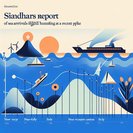
Researchers from the Centro Studi e Ricerche IDOS presented the 2025 edition of the ‘Dossier Statistico Immigrazione’ at Rome’s Teatro Orione on 4 November. The annual compendium—compiled in partnership with the Institute of Political Studies ‘S. Pio V’—offers the most granular snapshot of foreign-born populations, labour-market participation and remittance flows in Italy.
Key findings show that net immigration fell to 251,000 entries in 2024 (-7 % year-on-year) despite a record 585,000 first-time residence-permit quotas being available. Meanwhile, vacancies in manufacturing, logistics and elderly-care rose 13 % as the native workforce continues to age. The report warns that without a substantial bump in legal labour migration, Italy risks a cumulative shortfall of 1.4 million workers by 2030.
![New Immigration Statistical Dossier 2025 unveiled in Rome highlights shrinking inflows and rising skills gaps]()
For employers the dossier is a data goldmine: it breaks down permit issuance by province, sector and nationality, helping HR departments align recruiting strategies with quota availability. It also details average processing times—now 93 days for non-seasonal permits—enabling companies to plan project start-dates more realistically.
Policy-makers attending the launch—including officials from the Ministries of Interior and Labour—hinted that the 2026–28 ‘decreto flussi’ may be front-loaded, allocating 60 % of permits in the first 18 months to tackle immediate shortages. Advocacy groups used the event to push for faster family-reunification channels and recognition of overseas vocational qualifications.
Copies of the 400-page dossier were distributed free of charge, and a downloadable PDF is available for mobility practitioners who need evidence-based inputs for cost-benefit analyses of assignment locations.
Key findings show that net immigration fell to 251,000 entries in 2024 (-7 % year-on-year) despite a record 585,000 first-time residence-permit quotas being available. Meanwhile, vacancies in manufacturing, logistics and elderly-care rose 13 % as the native workforce continues to age. The report warns that without a substantial bump in legal labour migration, Italy risks a cumulative shortfall of 1.4 million workers by 2030.

For employers the dossier is a data goldmine: it breaks down permit issuance by province, sector and nationality, helping HR departments align recruiting strategies with quota availability. It also details average processing times—now 93 days for non-seasonal permits—enabling companies to plan project start-dates more realistically.
Policy-makers attending the launch—including officials from the Ministries of Interior and Labour—hinted that the 2026–28 ‘decreto flussi’ may be front-loaded, allocating 60 % of permits in the first 18 months to tackle immediate shortages. Advocacy groups used the event to push for faster family-reunification channels and recognition of overseas vocational qualifications.
Copies of the 400-page dossier were distributed free of charge, and a downloadable PDF is available for mobility practitioners who need evidence-based inputs for cost-benefit analyses of assignment locations.









